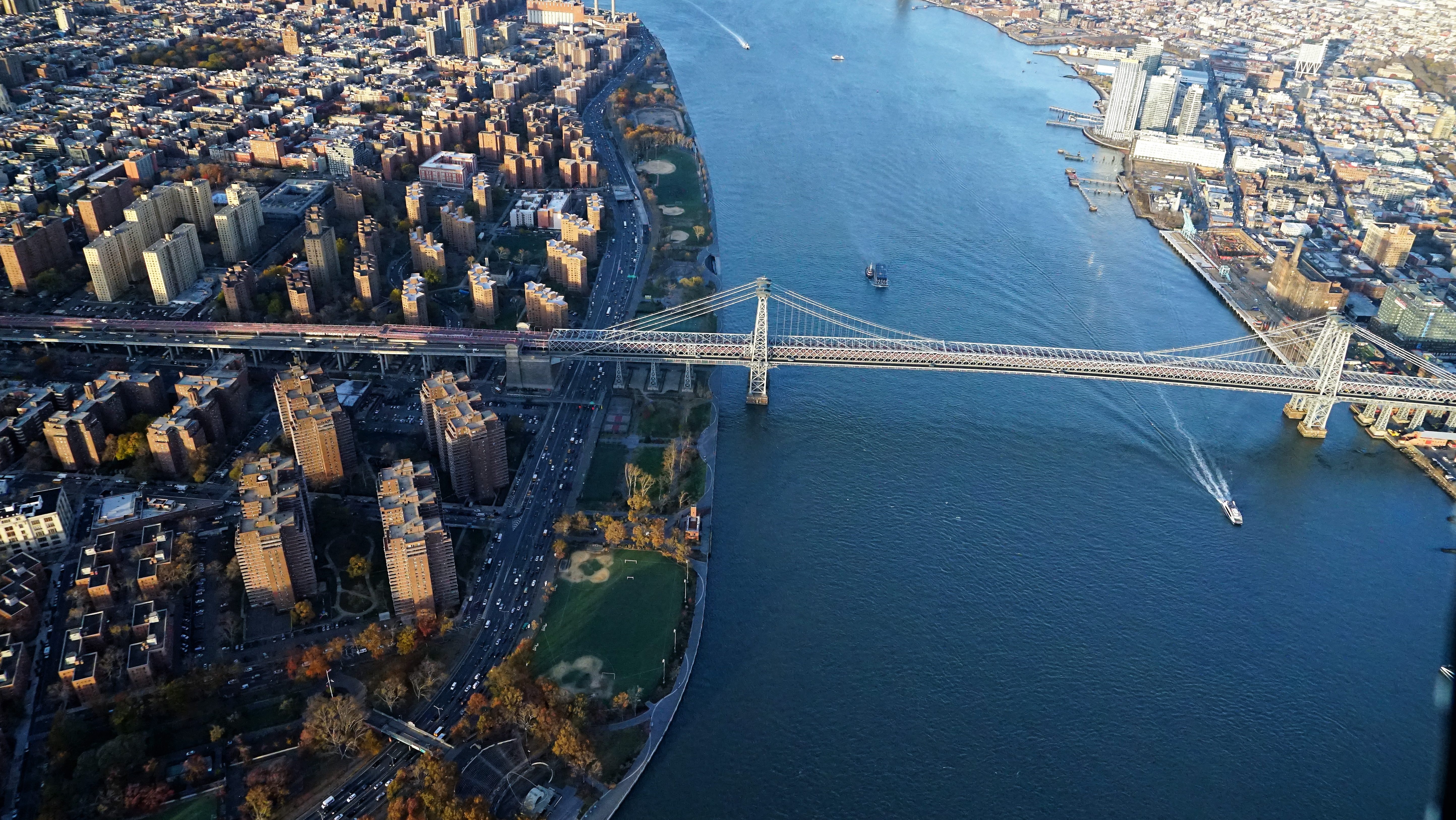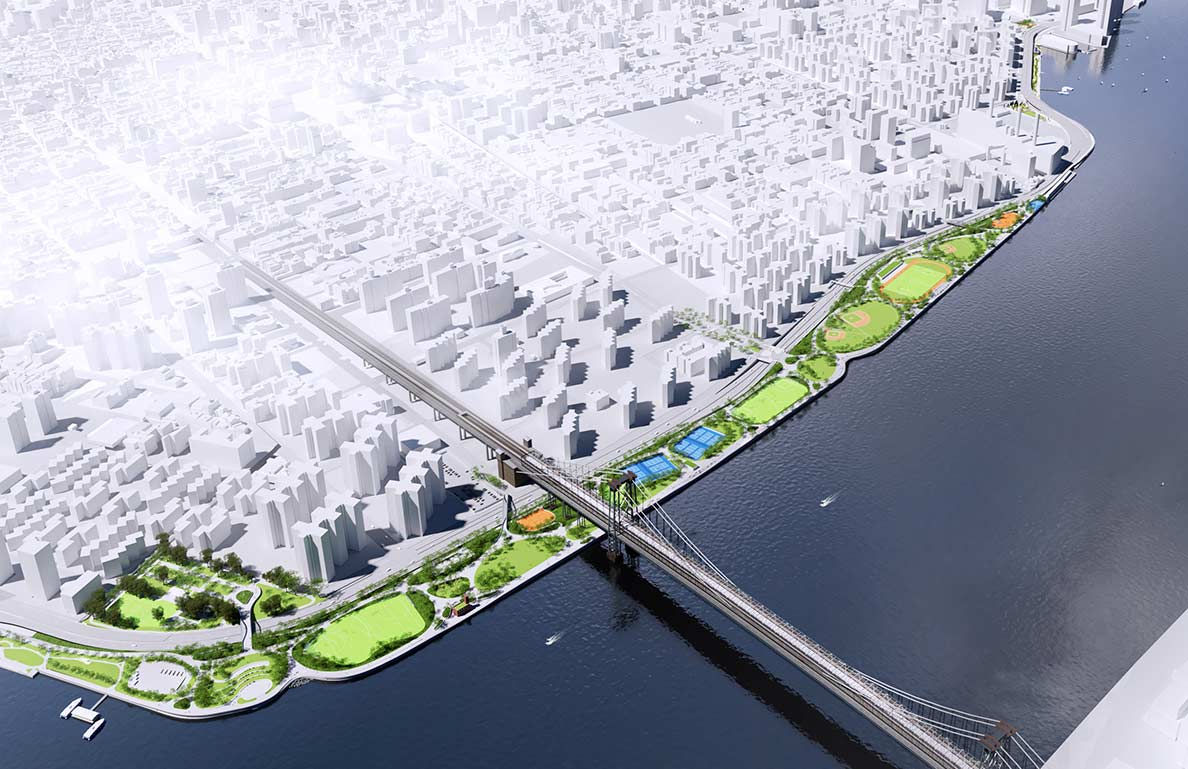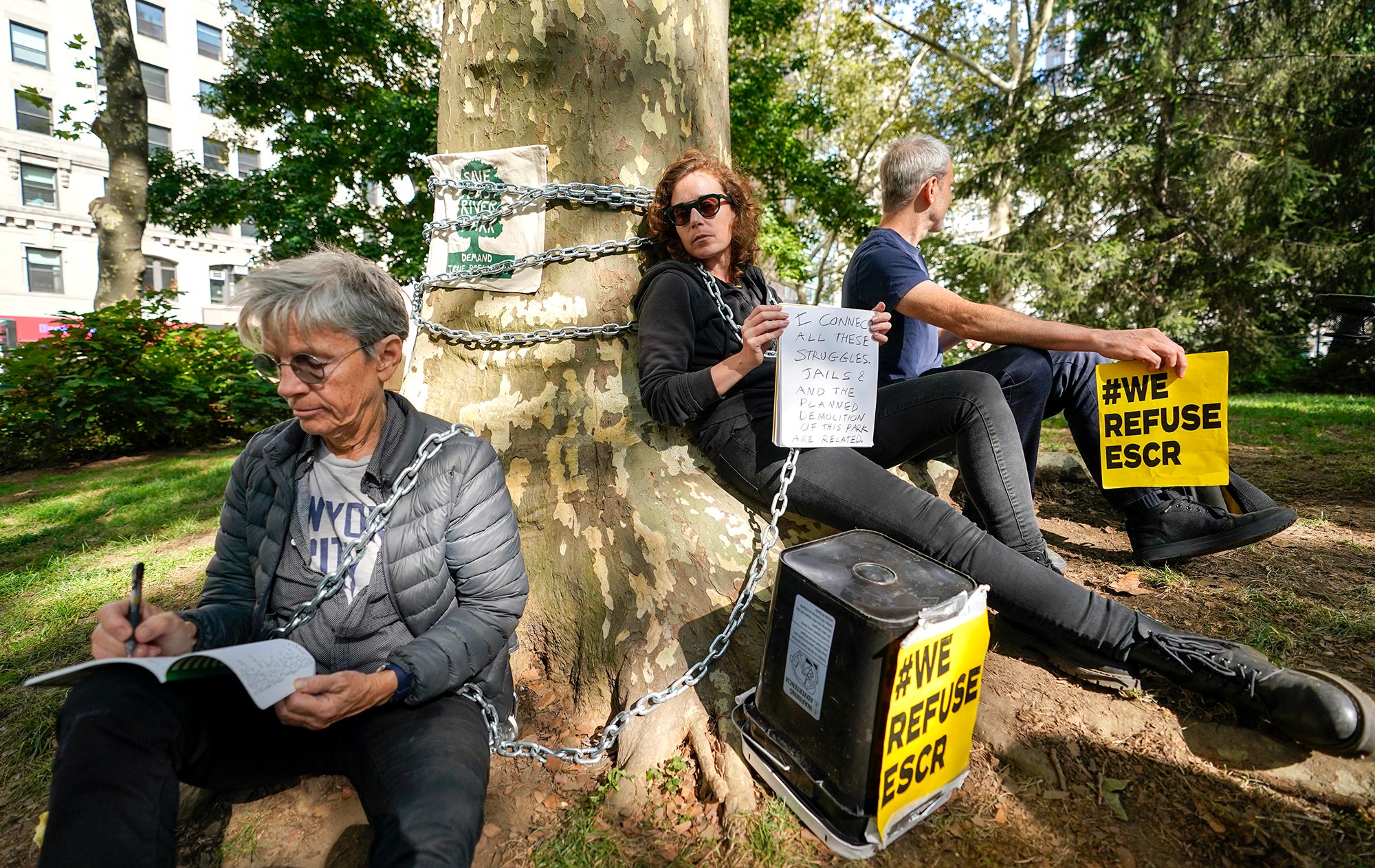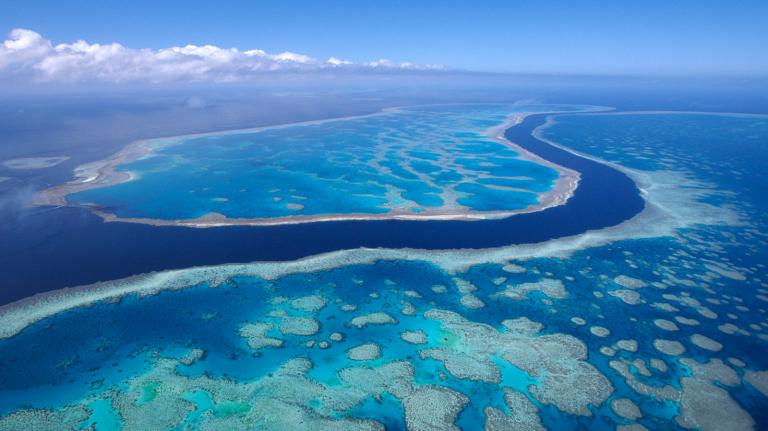Robert Moses, the public official responsible for transforming much of New York City’s landscape in the 20th century, built East River Park in the 1930s. It’s a ramshackle stretch of land that sits on the other side of a six-lane highway from four mammoth public housing complexes. Until recently, it was home to basketball courts, barbecue pits, and a large, concrete amphitheater. East River Park is the biggest green space in Manhattan south of Central Park and an oasis in a neighborhood that doesn’t have many options when it comes to outdoor areas. Like the rest of lower Manhattan, East River Park is threatened by sea-level rise spurred by climate change and by storm surge during hurricanes like 2012’s Superstorm Sandy.
The city of New York has a plan to transform the park over five years into a protective buffer between rising seas and lower Manhattan as part of its $1.45 billion East Side Coastal Resilience project, a flooding protection development that, once completed, will stretch from East 25th Street southward to the Lower East Side. Using federal and city funds, New York City plans to fully demolish the old park, which it began doing in December, and build a new park on top of it. Once completed, the entire 2.4-mile project will serve as a barrier between rising seas and the 110,000 residents who live near the water. But the city has faced fierce opposition from a small, organized group of community members who say the plan will temporarily eliminate an important community resource, change East River Park for the worse, and have negligible impact on storm surge and flooding.

On its face, it doesn’t make much sense for a community to oppose a project aimed at saving it from sea-level rise. But the East River Park controversy highlights what can happen when a city fails to adequately seek community input. As more cash flows to states and cities to fund climate resilience, thanks to the Biden administration’s environmental justice agenda and money earmarked in the bipartisan infrastructure bill passed last year, public officials are at risk of repeating New York City’s blunder. Experts told Grist that when officials fail to consult the communities they serve ahead of a project like East River Park, that project is destined to falter, fail, or wind up inadequately addressing the threat it’s meant to allay.
“I think in 30 years we’re going to look back and what we’re going to see is the communities that were most successful were the ones that had the courage to engage their community members very early on about the problems they’re facing,” Rob Moore, a senior policy analyst at the Natural Resources Defense Council, told Grist. “If you want to wait until you’re in the middle of a disaster recovery operation to figure out your plan, you’ve already lost.”
The hullabaloo over the new East River Park stems from an unexpected change of plans. In 2018, six years after Sandy, the city finalized a plan, with community input, to make a part of the park into an “undulating berm” — an elevated piece of land covered in plants and trees that would serve as a barrier between the river and the rest of the park. The park itself would act as a flood plain, turning into a large sponge when a Sandy-like event rolled through and protecting nearby residents from flooding.
But then the city brought in a group of engineers who determined that the original plan wasn’t feasible. The berm was to be built on high-voltage power lines owned by Consolidated Edison, the largest investor-owned utility in the United States, which would require the company to build a tunnel around its lines. Plus, the New York City Parks Department would have to maintain a park that doubled as a wetland — try keeping a public space clean and accessible when it’s covered in a foot of water — and the Department of Transportation would have to arrange the closure of a highway lane for construction to proceed. The clock was ticking: A significant portion of the $335 million the federal government was kicking in for the construction of the project was set to expire in 2022. (The deadline has since been extended to 2023.)
In March 2018, just a few months after the city had finalized its original plan, it announced that the old plan had been scrapped and a new effort was underway: The park would be buried under eight feet of landfill, and a new park would be built on top — effectively turning the park into a sea wall high enough to protect inland areas from storm surge.

“They switched the plan after four years of consulting the community and actually co-designing a real resilience plan,” Harriet Hirshorn, a documentary filmmaker who has lived a few blocks from East River Park for 40 years, told Grist. She’s a member of a group called East River Park Action that has been fighting the city over the project since 2018. “That whole action of having a meeting behind closed doors and completing changing a plan, erasing the community input by doing so, just fomented incredible mistrust.”
Changing course isn’t inherently a bad thing, Deborah Morris, the former executive director of resiliency planning for NYC’s Department of Housing Preservation and Development, told Grist. But the city “did a terrible job communicating about it,” she said.
The community was blindsided. The original plan, the one they had had the opportunity to weigh in on, was cheaper than the new plan and would have kept most of East River Park intact by installing berms and flood barriers along the highway. The new plan got rid of the old park entirely. Hirshorn and other community members also questioned the city’s decision not to turn the park into a flood plain when the threat of flash downpours is on the rise — particularly after the remnants of Hurricane Ida brought unprecedented flash flooding to the city last fall.
Community opposition to the new project sprang up just as quickly as the city had changed its mind about which plan to pursue. In early 2021, East River Park Action sued the city to stop it from uprooting the existing park. The group managed to delay elements of the construction process until this past December, when a judge denied the activists’ appeal and dismissed the case.
“The approach that the city took is a case study in how not to do things,” Karen Imas, vice president of programs at the New York-based nonprofit the Waterfront Alliance told Grist. “When you need to revisit a project or revisit designs, you really need to make sure that the community is a partner and that they really understand why certain decisions are being made.”
A spokesperson for the mayor’s office of New York City declined to provide comment for this story.
East River Park is not an outlier in the world of flood control projects. Similar sagas have played out across the country in recent years. In South Carolina, a plan to ring downtown Charleston with concrete sea walls is facing opposition from community members who want more input in the planning process. The plan has been delayed more than a year due, in part, to community backlash. In Miami, Florida, a similar plan to construct a sea wall rising 20 feet in some places across Biscayne Bay is sputtering thanks to pushback from community members who argue that the plan leans too heavily on metal and concrete infrastructure in lieu of green solutions and will be detrimental to quality of life in downtown Miami.
It’s not always easy to tell the difference between communities asking in good faith for more input on climate resilience projects and those attempting to derail initiatives that would benefit the common good. Wealthy owners of coastal properties in New York state opposed the Federal Emergency Management Agency’s new flood maps aimed at better representing the true flood risk because it raised insurance rates for higher-cost homes. In California, the San Diego town of Del Mar rejected a plan that would have helped residents safely retreat from encroaching sea water because homeowners, many of them wealthy, didn’t want to leave their homes.
Even the East River Park controversy fits in this category to some extent. Much of the vitriol against the city’s revised plan came from a particularly vocal group of middle- and upper-class white residents who had a sentimental attachment to the park. Tenant leaders from the neighborhood’s public housing initially opposed the new park plan but quickly reversed course and threw their support behind the project.

Resiliency is messy. It requires a lot of concrete, a lot of construction, a lot of noise. It might require old buildings to come down and new, stronger ones to be built in their place. It’ll require Western states to thin their forests so that wildfires don’t explode out of control and Gulf Coast states to dismantle infrastructure that accelerates erosion. And, ultimately, it means a lot of people will need to leave their homes in coastal and disaster-prone areas. None of that is particularly fun and, oftentimes, it is incredibly divisive and painful.
Experts say the projects that have been able to move forward, the initiatives that were most successful in uniting the disparate factions of a neighborhood or town, have one thing in common: Local public officials reached out to their constituents early and often.
Just a few blocks south of where the East Side Coastal Resilience Project ends, New York City is planning to create a flood barrier that stretches from the Manhattan side of the Brooklyn Bridge to the southernmost tip of the borough, in order to protect the Financial District and Seaport neighborhoods from rising seas. The city’s plan is to elevate one mile of shoreline while keeping the historical and recreational value of the waterfront intact.
It won’t be easy, but the plan hasn’t received the vitriol the East River Park project faced. That’s partly because the project doesn’t involve closing a large, beloved green space for half a decade; the one-mile waterfront between Brooklyn Bridge and Battery Park is more commercial than the area near the East Side Coastal Resilience Project. But it’s also because the city launched a two-year public planning process in 2019 that brought the many disparate factions of the community together, not to weigh in on an existing plan, but to actually create it and guide the project into fruition. The plan the community worked on is the plan the city is sticking with. “There was a lot of feedback and a lot of changes to the design that were born out of community feedback,” Imas said. “It wasn’t just marginally tweaking at the edges but real, substantive change based on what they heard from the community.”
Building out channels of communication between communities and public officials has never been more important. Last year, climate disasters in the U.S. claimed nearly 700 lives and inflicted more than $145 billion in damage. If every town in America had elected officials who knew what specific climate-related threats their constituents faced and worked preemptively to make communities more resilient to those threats, the number of people who die in disasters and the staggering amount of money spent on recovery would both go down.
“We need to build capacity,” Moore, from NRDC, said. Disaster recovery experts agree that every community in the U.S. needs an emergency manager whose job it is to prepare for disasters and recover from them. They also say states need to provide resources to those managers and make sure there’s someone in state government whose job it is to apply for federal funding for resilience work. And, when that funding comes through, experts say emergency managers and other local officials must look to their communities for input early and often. Not just the community members who pay the most in taxes, but the whole community. “The most vulnerable should be the first ones to have an opportunity to engage in these planning processes,” Imas said.
Harriet Festing, co-founder and director of Anthropocene Alliance, a Florida-based network of frontline communities who advocate for climate justice, agrees that building out capacity at the local level is imperative to achieving climate resilience. Much of her work focuses on educating communities and local officials about climate change, empowering them to advocate for the solutions they want, and then connecting them to the resources that will help them put those solutions into motion. She worries that the federal government doesn’t understand the barriers between municipalities and the climate adaptation projects they so badly need. “They’re so far away from even being able to start to put in an application,” she said. “They’re just in crisis mode and they don’t have a project to apply for, and they can’t have the staff to think about a project to apply for.”
Meanwhile, the battle over East River Park continues. In January, Christopher Marte, a Democratic member of the New York City Council, sent an open letter to the commissioner of the New York City Department of Design and Construction, on behalf of residents of the Lower East Side. He requested that the city test the construction site of the new East River Park for air pollutants, provide daily air quality reports to the public, and, lastly, “establish a clear channel to hear community feedback.” The community is still fighting to be heard.




